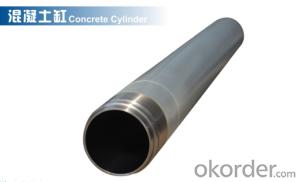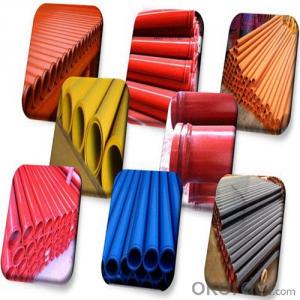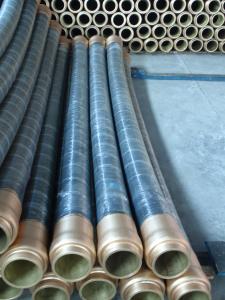DELIVERY CYLINDER(PM ) I.D.:DN200 CR. THICKNESS :0.25MM-0.3MM COLOR:WHITE LENGTH:1585MM
- Loading Port:
- Shanghai
- Payment Terms:
- TT OR LC
- Min Order Qty:
- 2 pc
- Supply Capability:
- 1000 pc/month
OKorder Service Pledge
Quality Product, Order Online Tracking, Timely Delivery
OKorder Financial Service
Credit Rating, Credit Services, Credit Purchasing
You Might Also Like
Packaging & Delivery
| Packaging Detail: | wooden case, seaworthy packing |
| Delivery Detail: | 15 days |
Specifications
Concrete Pump Delivery Cylinder DN230*2100
1. Capacity: 60,000~80,000cbm
2. Size: DN180, DN200, DN230..
4. Brand: PM, Sany,ZM
Concrete Pump Delivery Cylinder DN230*2100
1. Material: C45
2. quenching and tempering to improve the hardness to HB241-280
3. inner wall chrome thickness is 0.25-0.30mm, hardness HV820-900.
4. Brand: SCHWING, PM, SANY, KYOKUTO, CIFA
5. Capacity: 60,000~80,000cbm





- Q: How can one differentiate between genuine and counterfeit concrete pump spare parts?
- Differentiating between genuine and counterfeit concrete pump spare parts can be a challenging task, but there are several ways to ensure you are purchasing authentic components. Here are some strategies to consider: 1. Research the Manufacturer: Start by conducting thorough research on the manufacturer of the concrete pump spare parts. Look for reputable and established companies with a proven track record. Check their website, read customer reviews, and analyze their industry standing. Genuine manufacturers usually have a strong online presence and provide detailed information about their products. 2. Verify the Supplier: When purchasing spare parts, it is crucial to choose a reliable and authorized supplier. Make sure the supplier has a good reputation in the industry and has been in the business for an extended period. Authorized distributors often have a direct relationship with the manufacturer and can provide genuine parts. 3. Inspect Product Packaging: Genuine concrete pump spare parts often have specific packaging that includes branding, logos, and detailed product information. Counterfeit products may have poor quality packaging or contain misspellings, incorrect logos, or inconsistent color schemes. Examine the packaging closely to determine its authenticity. 4. Check Product Quality and Finish: Counterfeit parts are often made from low-quality materials and lack the precision and finish of genuine parts. Inspect the spare parts for any signs of poor workmanship, rough edges, or uneven surfaces. Genuine parts are usually well-crafted and undergo strict quality control measures. 5. Compare Prices: Be cautious of significantly lower prices for spare parts, as it could be an indication of counterfeit products. Counterfeiters often sell their goods at a lower price to attract customers, but the quality and performance may be compromised. Compare prices with other suppliers to ensure they are within the expected range. 6. Seek Expert Advice: If you're uncertain about the authenticity of concrete pump spare parts, consult with industry experts or experienced professionals. They can guide you in identifying genuine components and help you make informed decisions. 7. Request Certifications and Documentation: Genuine manufacturers provide certifications and documentation, such as ISO certifications or test reports, to validate the quality and authenticity of their products. Ask the supplier for these documents and verify their legitimacy with the manufacturer if necessary. Remember, purchasing genuine concrete pump spare parts is essential for the safety and efficiency of your equipment. By following these steps and exercising caution, you can minimize the risk of buying counterfeit components and ensure the longevity and reliable performance of your concrete pump.
- Q: How does a hydraulic accumulator improve the performance of a concrete pump?
- To ensure a constant and reliable flow of concrete, a hydraulic accumulator is employed to enhance the performance of a concrete pump. The primary role of this hydraulic device is to store hydraulic energy in the form of pressurized fluid. In the case of a concrete pump, it stores and releases energy from the hydraulic system as needed during the pumping process. Efficiency and productivity in concrete pumping rely on a consistent flow of concrete. However, variations in demand or pressure fluctuations can pose challenges. This is where the hydraulic accumulator comes into play. By storing surplus hydraulic energy, the accumulator acts as a buffer, smoothing out any irregularities in the hydraulic system. When additional power is required, the stored energy is released, providing a boost to the hydraulic system. This ensures a continuous and steady flow of concrete, even during periods of high demand or pressure changes. Furthermore, hydraulic accumulators also contribute to reducing wear and tear on the pump components. By absorbing and dampening pressure shocks, they prevent sudden spikes and fluctuations from reaching the pump. This helps to extend the pump's lifespan and minimize the risk of breakdowns or damage. Overall, a hydraulic accumulator plays a critical role in enhancing the performance of a concrete pump. It ensures a steady flow of concrete, reduces pressure fluctuations, and protects the pump from excessive wear and tear. This results in improved efficiency, reliability, and durability of the pump, ultimately leading to increased productivity and cost savings in concrete pumping operations.
- Q: What are the different types of concrete pump hopper agitator shaft seals?
- There are various types of concrete pump hopper agitator shaft seals, including packing seals, mechanical seals, and lip seals.
- Q: Are there any specific cleaning and maintenance procedures for concrete pump spare parts?
- Yes, there are specific cleaning and maintenance procedures for concrete pump spare parts. For cleaning, it is important to remove any concrete buildup or residue from the spare parts regularly. This can be done by using a high-pressure water jet or by soaking the parts in a cleaning solution specifically designed for concrete. It is essential to follow the manufacturer's instructions when using cleaning agents to ensure the safety and effectiveness of the cleaning process. In addition to cleaning, regular maintenance is necessary to ensure the longevity and proper functioning of concrete pump spare parts. This includes inspecting the parts for any signs of wear, such as cracks or corrosion, and replacing them if necessary. Lubrication of moving parts, such as bearings or pistons, should also be done as per the manufacturer's recommendations. It is important to note that different concrete pump spare parts may require specific cleaning and maintenance procedures. Therefore, it is advisable to refer to the manufacturer's guidelines or consult with a qualified technician to determine the appropriate cleaning and maintenance procedures for each specific part.
- Q: Are there any specific maintenance procedures for concrete pump spare parts?
- Concrete pump spare parts require specific maintenance procedures to ensure effective functioning and longevity. It is crucial to regularly maintain them. Here are some key maintenance procedures for concrete pump spare parts: 1. Lubrication: Minimize friction and wear by regularly lubricating moving parts like pistons, cylinders, and valves. This helps maintain smooth operation and prevent premature failure. 2. Cleaning: Regularly clean spare parts to remove debris, dirt, or concrete buildup. Accumulated material can hinder performance and cause damage. Use appropriate cleaning agents and tools for thorough cleaning. 3. Inspection: Routinely inspect spare parts for signs of wear, damage, or deterioration. Check for cracks, leaks, loose connections, or abnormal functioning. Promptly detect issues for timely repairs or replacements. 4. Replacement: Immediately replace worn-out or damaged spare parts. Delaying replacements can lead to further damage and costly repairs. Follow the manufacturer's recommendations for part lifespan and replacement. 5. Calibration: Correctly calibrate spare parts to maintain optimum performance. Adjust pressure settings, flow rates, and other parameters according to manufacturer's guidelines. Regular calibration ensures accurate and efficient concrete pumping. 6. Storage: Properly store spare parts to prevent damage from environmental factors. Keep them in a clean, dry place away from direct sunlight or extreme temperatures. Follow any specific storage instructions from the manufacturer. 7. Training: Train operators and maintenance personnel on proper handling, maintenance, and repair of spare parts. This ensures correct procedures are followed, minimizing damage risk and maximizing equipment lifespan. Following these maintenance procedures will keep concrete pump spare parts in optimal condition, enhancing performance, reliability, and longevity.
- Q: How do I properly maintain and replace hydraulic filters in concrete pump spare parts?
- Proper maintenance and replacement of hydraulic filters in concrete pump spare parts is crucial to ensure the longevity and efficiency of your equipment. Here are some steps to follow: 1. Understand the manufacturer's recommendations: Start by familiarizing yourself with the manufacturer's guidelines for maintaining and replacing hydraulic filters. These instructions may vary depending on the specific pump model and filter type. 2. Regular inspection: Regularly inspect your hydraulic filters for any signs of damage, clogging, or excessive wear. Look for dirt, debris, or other contaminants that may hinder the filter's performance. If you notice any issues, it is important to address them promptly. 3. Follow a maintenance schedule: Implement a regular maintenance schedule for your hydraulic filters. This schedule should include regular filter inspections, cleaning, and replacement intervals. Adhering to a schedule will help prevent unexpected breakdowns and keep your concrete pump running smoothly. 4. Cleaning the filters: If your hydraulic filters are designed to be cleaned and reused, make sure to follow the proper cleaning procedure. This typically involves removing the filter, washing it with an appropriate cleaning solution, and allowing it to dry thoroughly before reinstallation. Be cautious not to damage the filter during the cleaning process. 5. Replacement: Over time, hydraulic filters will become less effective at filtering out contaminants. It is important to replace them according to the manufacturer's recommended intervals or sooner if they appear excessively dirty or damaged. Always use genuine spare parts to ensure compatibility and optimal performance. 6. Proper installation: When replacing hydraulic filters, ensure that they are installed correctly and securely. Pay attention to any seals or gaskets that may need to be replaced as well. Improper installation can lead to leaks or reduced filtration efficiency. 7. Monitor performance: After replacing the hydraulic filters, monitor the pump's performance closely. Pay attention to any changes in pressure, flow rate, or unusual noises. If you observe any abnormalities, it may indicate a problem with the filter or other components, and further investigation may be necessary. By following these steps, you can properly maintain and replace hydraulic filters in your concrete pump spare parts, ensuring optimal performance and prolonging the lifespan of your equipment.
- Q: What are the different types of concrete pump hopper agitator motors?
- There are generally two types of concrete pump hopper agitator motors: electric motors and hydraulic motors. Electric motors are powered by electricity and are commonly used in smaller and portable concrete pumps. Hydraulic motors, on the other hand, are driven by hydraulic power generated by the concrete pump itself and are typically used in larger and stationary concrete pumps.
- Q: Can I get spare parts for both concrete pumps with and without water tanks?
- Indeed, spare parts are readily accessible for both concrete pumps equipped with water tanks and those without. A multitude of manufacturers and suppliers present an extensive array of spare parts for concrete pumps, encompassing diverse models with or without water tanks. These spare parts serve the purpose of regular maintenance, repairs, or replacements for a variety of components, including hoses, pipes, valves, cylinders, seals, and other essential elements. Prioritizing the acquisition of appropriate spare parts tailored to your specific concrete pump model is crucial to guarantee compatibility and achieve optimal performance.
- Q: How often should concrete pump control levers be inspected and replaced?
- Regular inspections should be conducted on concrete pump control levers to ensure they are in proper working order. The frequency of these inspections and any necessary replacements will depend on various factors, such as usage levels, environmental conditions, and the quality of equipment maintenance. As a general rule, it is recommended to inspect the control levers at least once a year. This inspection should involve a thorough examination of the lever mechanism to check for any signs of wear, damage, or malfunction. It is also advisable to inspect the levers after any major repairs or maintenance to ensure they have been correctly reinstalled and are functioning properly. If any issues are identified during the inspection, it is crucial to address them promptly. Depending on the severity of the problem, repairs or replacements may be required. Minor repairs can often be carried out on-site, while more significant issues may necessitate the assistance of a professional technician. Regular maintenance, including lubrication and cleaning, is important for extending the lifespan of the control levers. Following the manufacturer's maintenance and usage guidelines can also help prevent premature wear and damage. Ultimately, the frequency of inspections and replacements may vary based on specific circumstances. It is advisable to consult the equipment's manual or the manufacturer for precise recommendations regarding the maintenance and replacement of the control levers.
- Q: What is the function of a concrete pump hydraulic motor?
- The concrete pump hydraulic motor serves the purpose of supplying the essential power and force needed for the operation of the concrete pump. Its responsibility lies in transforming hydraulic energy into mechanical energy, thereby enabling the pump to function with efficiency and effectiveness. By propelling the pumping mechanism, it allows the concrete to be transported through the pipeline and delivered to the desired destination. Additionally, the hydraulic motor governs the pump's speed and direction, facilitating accurate placement of the concrete. In conclusion, the concrete pump hydraulic motor plays a vital role in guaranteeing the seamless operation and triumphant delivery of concrete in construction endeavors.
Send your message to us
DELIVERY CYLINDER(PM ) I.D.:DN200 CR. THICKNESS :0.25MM-0.3MM COLOR:WHITE LENGTH:1585MM
- Loading Port:
- Shanghai
- Payment Terms:
- TT OR LC
- Min Order Qty:
- 2 pc
- Supply Capability:
- 1000 pc/month
OKorder Service Pledge
Quality Product, Order Online Tracking, Timely Delivery
OKorder Financial Service
Credit Rating, Credit Services, Credit Purchasing
Similar products
Hot products
Hot Searches
Related keywords























